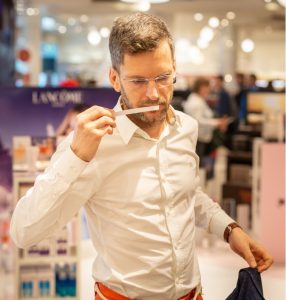HOW WILL THE PERFUMER BECOME A PÁLINKA MASTER?
As a perfumer, I have been involved in many interesting projects with renowned alcoholic beverage producers to collaborate in organoleptic tests for product development or marketing purposes. For decades, I am a regular guest at VinCE and similar professional events, and winemakers, star chefs and distilleries ask for my opinion on the scents, I experience. They do this because I often formulate a perfumer’s opinion, that even gives the most experienced professionals a sense of ’aha’, this is not because I would have a much better nose, but rather as I smell different things and much more. I do not feel fundamentally different from a person with an average nose; I only notice much more detailed information. All this is done consciously since I was a kid, so I don’t have any ’pálinka panels’ like this. That is why I think they asked me to give a lecture on the then-started Pálinka Master technical course education at the Corvinus University of Budapest, which program I liked so much I asked for the application to join, so I could finish with the country’s best pálinka experts. I could learn from great teachers, such as from the beloved Cila (editor’s note: Gáborné Panyik, dr.) I have known during my first 40 years the pálinka only as a necessary evil, it was only through the education course of Pálinka Master training, when I have been confronted with the organoleptic properties of this exceptional beverage. I have fallen in love with the pálinka culture for only a few years’ time now, but since this I have been experiencing all the encounters as aroma and flavour orgies.
WHAT IS SMELLING?
Smell is our oldest sense organ. Professor János Szentágothai, in his three-volume rightly adored – and feared during the anatomy exams – book “Functional Anatomy” enumerates the brain nerves in Latin numbers. The smell nerve belongs to the Latin I category. If he puts it in the first place, there is a reason. We are the first to develop our sense organs in both tribal and individual development. Which means we smelled, before we saw or heard. This is also true during the evolutionary development, leading to Homo sapiens and during our own evolution in the abdomen of our mother. The olfactory nerve, also called as external brain tissue, provides such a direct and fast connection to deeper brain areas. In addition, these are ancient parts where emotions, love-hate-like-neutral feelings develop before the higher, conscious socalled cortical processing. Adding to this, the area of memory in the brain is also very close. That is why a scent, smell or aroma – associated with a pleasant or negative experience – will be remembered back 100 years and a single sniff of that particular scent will instantly bring back to most of us, almost with cinematic accuracy and a specific emotion. It is no coincidence, therefore, that when you smell a specific, ever-tasted pálinka, open an old bottle, even decades after the death of the grandfather, the happy moment and every circumstance come back, when and how it was served by him.
Another fascinating feature of our sense of smell is the ability to sense the taste (that is, to recognize, remember and understand the combinatorial properties of the saliva, dissolved in the mouth), approximately 60-70% related to the sense of smell, i.e. the volatile molecular, complex smell. This makes it repeatable, the basis for cooking over and over again the old recipe, learned from our grandmother, even without a cookbook, or for producing the same pálinka with the very same aroma world. The sense of smelling can be improved, the nose can be taught, but it cannot be replaced, if it is lost. If a master chef, pálinka master, celebrity confectioner or perfumer loses his sense of smell due to an accident or illness and simply suffers from ‘nasal blindness’, then the taste, complexity of his taste perception will unfortunately be reduced to a fraction, but it will no longer be able to perform as previously. Our healthy nose is actually a pretty fatigue item. I usually say that you should treat it like any of your muscles. It should be taught, trained and exercised, rested and controlled, otherwise it gets easily exhausted and do not serve us if we are suddenly overloaded. We have already experienced that if we go into a perfumery, most of us will feel the same after 3-4-5 fragrances, because they are not used to this workout, which is largely due to the lack of exercise. An experienced perfumer like me feels the same trouble after 100 scents. Smells and fragrances are information, but in my opinion the scent is an invisible aesthetic beauty, that can be found in anything. This is why, I find it important to teach an average person how to pay attention to the scents around him.
The role of smell in the production, assessment and tasting of pálinka Since our sense of smell is one of our most important senses, it is no wonder, that we need our nose at every stage of the making of spirit, that is the one, we use to detect and classify fragrances and aromas. In my professional opinion, making pálinka is a practical profession, that cannot be learned from textbooks alone. The story begins with good quality fruit, continues with the correct mashing, ending with distilling and pinpoint separation. The perfect distinction between preand post-spirits requires a cold-hearted, almost cruel professionalism from a good master, a well-trained nose. This is why I think this is a related profession to perfume mixing. Of course, vintage also influences how good pálinka is made; like everything in agriculture, but the most exciting thing is that every batch will actually be different, resulting in a unique product – just like in perfume making.
A good pálinka critic is constantly training his senses. You know, during a pálinka tasting or professional review, we can quickly turn ourselves into an insensitive ‘woodpecker’ if we do not make it through the wake – including the necessary rest -, even our judgment of value could likely be flawed.
Resting is important and this doesn’t mean having a coffee, it’s forbidden, since coffee has more than 4000 volatile molecules, it does not help to recover the nose, but rather enhance the fatigue, 10-15 minutes walk on the fresh air is recommended with complete ’nasal abstinences’, hence not smelling anything, especially not alcohol. If we want to smell pálinka for our own entertainment, we can also train ourselves and train our nose. It is good to know the fruit, that the pálinka is made of, because this way we can evoke the aromas, recorded in our memories, mentioned in the sense of smell and know what marks we are looking for in the pálinka. However in order to get the perfect experience, if you do not know the particular fruit (since there are so many of them we cannot know all of them), then it is important to be open and let the nose (and mouth) smell, it finds the connection to the past, we have experienced in our memories with aromas and smells. This will decide, whether we like the pálinka or not.
WHEN THE ’NOSE’ TASTES APRICOT PÁLINKA
Fragrances are usually complex chemical systems, composed of hundreds or even thousands of fragrance molecules. Every fragrance – I encounter – I begin to break down into its creative elements, examining the characteristic base and side scents of the drink and characteristics, though subtle, fragrance notes, that make it unique and distinctive. Pálinka is an alcoholic beverage, containing a complex of thousands of different volatile fragrance molecules. The alcohol percentage is high, compared to other beverages, which can partially enhance some of the markings and partly suppress the aroma by adjusting the final alcohol percentage by volume. The aromas of apricot echo wonderfully in a well made pálinka. For the perfumer, the contrast between the sweet and sweet honey notes of the apricot are complemented by the fresh, green aromas, that give it acidity and tartness. The major aroma molecules in fruit and pálinka include gamma-decalactone, damascenone beta, delta-decalactone, linalool, beta-ion, 1,5-octadien-3-one, 2,6-nonadienal. It certainly doesn’t tell too much to non-organic chemist colleagues, but it’ll be more exciting to tell you about the scents of jasmine, acacia, linden, rose,violet, banana, dried carrot, iris, lavender, apple and cucumber. The distinctive benzaldehyde, that passes through the seeds of fruit, giving marzipan tones, if we can even find a seed character. While nature creates its delights by working from the same set of molecules, it sometimes leaves out a couple of creators, sometimes adds a few more, mixing just the proportions to create the aroma world of each of its creatures. It is the task of the pálinka master to deliver the most original aroma of the fruit. In this way, thanks to the combined work of nature and men, the irresistibly delicious, fruity apricot pálinka can be created.


